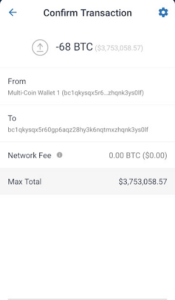How Do Bitcoin Transactions Work?

Cryptocurrencies are all the rave: There’s such an abundance of them on the market at the moment, but the biggest and a pioneer in the field is undoubtedly Bitcoin. It’s also the most valuable cryptocurrency, growing exponentially beyond anyone’s wildest imaginations.
Since Bitcoin and other cryptocurrencies are gradually becoming acceptable means of payment, there’s a need to get acquainted with them. This brings about the question: How do Bitcoin transactions work?
While we wait for the world to turn into a place where, as crypto enthusiasts describe it, “everyone could buy a Starbucks with Bitcoin”, let’s discuss some of the basic terms and concepts.
Bitcoin is a blockchain-based digital currency introduced by Satoshi Nakamoto in 2008. Think of it like digital money, with cryptocurrency transactions performing all the regular functions of paper money. However, you never get to see a bitcoin or hold it in your hand: There are no physical representations for the cryptocurrency.
The “crypto” part refers to encryption that all digital currencies running on blockchains have. With Bitcoin, a transaction is literally an exchange of digital values between two parties.
Satoshi created Bitcoin as a peer-to-peer electronic cash system. But instead of a banking environment, you have the blockchain.
The blockchain is a sort of shared public ledger which records every transaction. With the blockchain, Bitcoin wallets (which work like regular wallets) can calculate the balances before and after confirmed transactions have been recorded.
These transactions are highly secure thanks to public-key cryptography. Two keys are issued to every user; a private key and a public one. In a typical BTC transaction between you and another party, both of your public keys are shared and stored in the transaction details in the network. These details are then authorized with the private keys, which are encrypted and hence cannot be shared. Anyone who views the public keys can verify that the transaction has indeed been authorized with the private keys, but they can never view the private keys themselves. The network can automatically authenticate and validate the transaction and confirm that the transfer of coin ownership was successful.
We’ve established that transactions are an exchange of value between Bitcoin wallets. Now let’s touch on the verification of these transactions.
Bitcoin Transaction Verification
Every transaction needs to be verified. It’s a multi-step process. The transactions are first broadcast to the blockchain network. The verification process takes place within ten to twenty minutes through a process called mining. Mining is simply computing. It records and displays transactions in the blockchain network.
Mining is also the process by which new Bitcoin units are released into the network. Individuals called BTC miners contribute computing power to the mathematical process running the Bitcoin network and get rewarded with new units of Bitcoin.
Bitcoin Transaction Confirmation
A new block – discovered by miners through the mining process – is added to the blockchain approximately every ten minutes. This new block records and verifies any transactions performed within its time frame. Then we can say the network has confirmed a transaction.
Let’s look at a quick example. Suppose Max purchases Bitcoin and then sends some units to Juniper through his wallet. The transaction will be in transit and remain unconfirmed until a new block is created. When this happens, the transaction is added to that block. This counts as one confirmation. Every ten minutes afterward, a new block is created, and the network confirms the transaction again.
How Many Confirmations Are Enough?
BTC transactions require multiple confirmations because they run the risk of being reversed. The more confirmations there are, the less likely it is for a reversal to happen.
The number of confirmations required depends on how much Bitcoin is transferred. One base rule is you should wait for at least one confirmation for every transaction. One confirmation is enough for small Bitcoin payments of less than $1,000. Payments ranging from $1,000 to $10,000 require three confirmations. Six confirmations are enough for payments from $10,000 to $1 million. For transactions larger than $1 million, 60 confirmations are needed.
How To Do a Bitcoin Transaction
Now that we’ve covered the basics let’s see how you can carry out a transaction. It’s quite similar to conducting transactions using regular currency. The first thing you need is a Bitcoin wallet. The wallet works in the same manner as your bank account or eWallet.
Of course, you’ll also need spendable Bitcoin in the wallet. The easiest way to get it is to buy Bitcoin for the equivalent of government-issued currency. Suppose you have $600 in regular money; buying Bitcoin would give you $600 worth of Bitcoin in your wallet, which you can then send to other wallets.
Sending BTC
To send Bitcoin to another user either as a deposit or a payment for an item, you need three things: your Bitcoin wallet, the Bitcoin you seek to transfer, and the recipient’s wallet address. A wallet address is like an email address, and represents the identity of an individual’s wallet. Of course, you’ll also need an internet-connected device.
Next, you open the wallet app and select Send:
The next step is to copy and paste the recipient’s wallet address or scan the QR code.
Enter how much you want to send:
Crosscheck the transaction details:
Proceed with your transaction.
How To Receive BTC
Receiving Bitcoin is even easier than sending because, in this case, the transaction is coming from another end; your wallet is just the final destination.
It takes just a few steps to receive Bitcoin.
Open your wallet app and select Receive.
Choose which wallet you want to receive Bitcoin to. Make sure to select BCH for Bitcoin Cash and BTC for Bitcoin.
Copy your wallet’s BTC address and send it to the sender, or let them scan your QR code.
Voila! Wait for the transaction status to change from Pending to Successful.
Bitcoin Transaction Fees
Since Bitcoin is a decentralized network and the transactions are nearly real-time, there are no direct transfer fees. But as we mentioned in the Transaction Verification section, the transactions are verified through the mining process. The miners get a tip for every transaction; that sum is deducted as a transaction fee.
Most times, you do not even have to calculate it yourself, as most wallets account for the fees in every transaction, which is why you can only transfer slightly less than your total wallet balance. The remainder is the miner’s fee. You can check your wallet’s transfer fees in its manual.
How To Check a BTC Transaction
You can easily look up a cryptocurrency transaction and details about it online as you would any other transaction type. All you need to do is visit a block explorer, such as blockchain.com/explorer, and use the search bar on the upper right. You can learn more about a particular Bitcoin address, transaction hash, or block number by entering the necessary info into the search field. With the transaction ID, you can see how many times your transaction has been confirmed, as well as other details.
The Bottom Line
As you can see, there is nothing complicated about how a Bitcoin transaction works. Apart from being very straightforward, the process is also completely safe. All you need to start sending and receiving BTC is an eWallet and some Bitcoin.
Frequently Asked Questions (FAQ)
Can Bitcoin be converted to cash?
Yes, you can convert Bitcoin into any currency in the world. There are various channels for Bitcoin conversion such as selling Bitcoin on a crypto exchange, bank or Paypal transfers, Bitcoin ATMs (there were nearly 15,000 Bitcoin ATMs all over the world as of January 2021), Bitcoin debit cards (which function like regular debit cards), or peer-to-peer transactions.
How are Bitcoin transactions processed?
Transactions get inserted into the blockchain by nodes. Nodes are miners who connect to the network to find blocks and process transactions. When a person sends Bitcoin to another person, the miners run software to discover new blocks approximately every ten minutes and then add these transactions to the new blocks. The blocks are then connected to the blockchain. All transactions require at least one verification. The number of verifications depends on the amount of Bitcoin transferred.
Can police track Bitcoin transactions?
Contrary to popular belief, these transactions are traceable, unlike cash. While it may be difficult to figure out the parties in a transaction, it is possible to study the cryptocurrency’s patterns and movement to profile and identify suspects.
How long does it take to get your money from Bitcoin?
Most wallets require at least two confirmations to reflect fully in the balance. This can take anywhere from five minutes to an hour, but if everything is running well, the Bitcoin transaction process is relatively swift.




